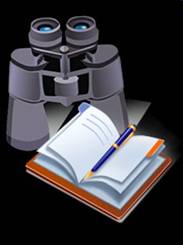Difference between revisions of "Field Animal Behavior"
| Line 74: | Line 74: | ||
| T 14 || Observational methods; cricket mating; Fenton River | | T 14 || Observational methods; cricket mating; Fenton River | ||
|| T 21 || Individual project presentations; Paper submission (Introduction and Methods) | || T 21 || Individual project presentations; Paper submission (Introduction and Methods) | ||
| − | || T 28 || | + | || T 28 || '''Leave at noon'''- Coastal fiddler crabs / Field notebooks (Final Submission) |
|- | |- | ||
| W 15 || Field research techniques, hypotheses testing, study design, and data analysis; Bicentennial Pond | | W 15 || Field research techniques, hypotheses testing, study design, and data analysis; Bicentennial Pond | ||
| Line 88: | Line 88: | ||
|- | |- | ||
| F 17 || Project guidelines discussion and selection (written ideas); local observations | | F 17 || Project guidelines discussion and selection (written ideas); local observations | ||
| − | || F 24 || | + | || F 24 || Individual project data collection II |
|| F 31 || FINAL EXAM; Instructor evaluations | || F 31 || FINAL EXAM; Instructor evaluations | ||
Revision as of 23:03, 13 May 2013
EEB 3898: Field Animal Behavior
May Term, May 13th - 31st, 2013 MTWThF 1-4pm Torrey Life Sciences, Rm 181
Instructor: Dr. Kristiina Hurme
Office: TLS 379
Phone: 860-486-5434
Office hours: variable & flexible (call, email, drop by)
Course Objectives
➢ Learn how to observe animal behavior
➢ Notice animal behavior in our daily lives
➢ Learn how to take field notes
➢ Learn and apply basic field techniques, study design, and data analysis
➢ Develop a research project
➢ Improve collaboration skills
Course Materials
• Required
o Binoculars (available from us if you don’t have any)
o Field notepad/notebook
o Watch with countdown timer that beeps
o Closed-toe shoes (no sandals) or hiking boots, & proper outdoor clothing (poison ivy, weather)
• Recommended
o Field Guides (birds, mammals, insects, etc.) for New England or Eastern US
o Camera
o Insect repellent (ticks, mosquitoes)
o Sunscreen, sunglasses, hat
Tentative* schedule
| Day | Topic | Day | Topic | Day | Topic |
|---|---|---|---|---|---|
| M 13 | Course introduction and timeline; What is behavior? | M 20 | Field notebooks (First Submission) | M 27 | MEMORIAL DAY - NO CLASS; make observations on your own! |
| T 14 | Observational methods; cricket mating; Fenton River | T 21 | Individual project presentations; Paper submission (Introduction and Methods) | T 28 | Leave at noon- Coastal fiddler crabs / Field notebooks (Final Submission) |
| W 15 | Field research techniques, hypotheses testing, study design, and data analysis; Bicentennial Pond | W 22 | MIDTERM EXAM; field observations after | W 29 | Project presentations and assisted work on the paper |
| Th 16 | ALL DAY - Trip to Zoo in Providence, RI; Ethograms | Th 23 | Individual project data collection I (Methods adjustment) | Th 30 | Review session in preparation for the final; PAPER SUBMISSION (FINAL) |
| F 17 | Project guidelines discussion and selection (written ideas); local observations | F 24 | Individual project data collection II | F 31 | FINAL EXAM; Instructor evaluations |
*: Schedule is subject to change pending weather conditions, or unforeseen observation and research opportunities.
Grading
Exams: May 22nd (MIDTERM) [50 points]; May 31st (FINAL) [50 points]
Project Paper:
May 21st (Intro and Methods) [30 points];
May 30th (Final) [50 points]
Project Presentations:
May 21st (Intro and Methods) [20 points];
May 29th (Final) [25 points]
Field Notebook Submissions:
May 20th (First) [20 points];
May 28th (Final) [25 points]
iNaturalist submissions:
2+ observations/day = 30 obs. [15 points];
5 min observations:
10 x 2 points [20 points]
Ethograms:
3 x 5 points [15 points]
Field trips = Behavioral observations (5 points each):
Dates will be weather dependent [30 points]
Total: [350 points]
Grading scale: A = 100-90%, B = 89-80%, C = 79-70%, D = 69-60%, F = 59-0%.
Plus/minus system will be used for the final grade.
Additional References & Websites
• Alcock, J (2001). Animal Behavior - An Evolutionary Approach (7th ed.). Sinauer Associates Inc. Publishers.
• Krebs, J. R. and N. B. Davies (1993). An Introduction to Behavioral Ecology (3rd ed.). Blackwell Scientific Publications.
• Martin, J. and P. Bateson (1993). Measuring Behaviour (2nd ed.). Cambridge University Press.
• iNaturalist: http://www.inaturalist.org/places/connecticut#
• Eastern Forests: A field guide to birds, mammals, trees, flowers, and more. Peterson Field Guides.
• Cornell Lab of Ornithology “All About Birds”: http://www.birds.cornell.edu/AllAboutBirds
• Natchaug Ornithological Society: http://www.nosbird.org/ (esp. “local hotspots” http://www.nosbird.org/hotspots.html)
• Connecticut Ornithological Association: http://www.ctbirding.org/index.htm
• CT Audubon Society: http://www.ctaudubon.org/
• CT Department of Environmental Protection: http://www.ct.gov/dep/site/default.asp
Website design by Diego Sustaita; Modified by Kristiina Hurme

